Wandering Jew
 From Nwe
From Nwe The Wandering Jew is a figure from medieval Christian that spread widely in Europe in the thirteenth century and became a fixture of Christian mythology and literature. It concerns a Jew who, according to legend, taunted Jesus on the way to the Crucifixion and was then cursed to walk the earth until the Second Coming.
The exact nature of the wanderer's indiscretion varies in different versions of the tale, as do his identity and aspects of his character. He is often called Ahasuerus, although sometimes he is associated with such biblical figures of Joseph of Arimathea and even the Apostle John. A variety of other names have been given to the Wandering Jew, including Melmoth, Matathias, Buttadeus, Cartophilus, Isaac Laquedem, Juan Espera a Dios (Spanish: "John [who] waits for God"), and also Jerusalemin suutari ("Shoemaker of Jerusalem" in Finnish). Literature detailing his exploits has appeared widely throughout modern history and was appropriated in anti-semitic tracts.
The "Wandering Jew" is also a personification of the Jewish diaspora—the scattering of the Jews throughout the world after the destruction of the Temple of Jerusalem in 70 C.E. during the Jewish Revolt against Rome. The two concepts are linked by the Christian perception that the destruction of Jerusalem was divine retribution for Jewish responsibility for the crucifixion of Jesus. The "Wandering Jew" theme has thus been made the vehicle for anti-Semitism. A modern allegorical view claims instead that the "Wandering Jew" personifies any individual who has been made to see the error of his or her wickedness.
A variation on the story was also applied to Longinus, the soldier who pierced Jesus' side while he hung on the cross. Yet another version declares that the wanderer is the attendant Malchus, whose ear Saint Peter cut off in the garden of Gethsemane (John 18:10), who was condemned to wander until the Second Coming.
At least from the seventeenth century, the name Ahasver has been given to the Wandering Jew, an unlikely one, on the face of it, adapted from Ahasuerus, the Persian king in Esther, who is not a Jew, and whose very name among medieval Jews was an exemplum of a fool.[1]
Origin of the legend
The legend of the wandering Jews is founded in part on Jesus' words given in Matthew 16:28: "Verily I say unto you, There be some standing here, which shall not taste of death, till they see the Son of Man coming in his kingdom." (KJV)[2]
The more specific belief that the Jew who betrayed Jesus would not die before the Second Coming is derived from an apparent misreading of the Gospel of John, in which the person referred to is actually Judas Iscariot but seems to have been confused with the disciple known as John the Beloved:
And Peter, turning about, seeth the disciple following whom Jesus loved, who had also leaned on His breast at the supper, and had said, 'Lord, which is he who betrayeth Thee?' When, therefore, Peter saw him, he said to Jesus, 'Lord, and what shall he do?' Jesus saith to him, 'If I will that he remain till I come, what is that to thee? follow thou Me.' Then this saying went forth among the brethren, that that disciple would not die.. (John 21:20-23, KJV)
A variant of the Wandering Jew is recorded in the Flores Historiarum by Roger of Wendover under the year 1228. An Armenian archbishop, then visiting England, was asked by the monks of St Albans Abbey about the celebrated Joseph of Arimathea, who had spoken to Jesus, and was reported to be still alive. The archbishop answered that he had himself seen him in Armenia, and that his name was Cartaphilus, a Jewish shoemaker. Jesus had stopped for a moment to rest while carrying his cross, when Joseph/Cartaphilus struck him, and told him "Go on quicker, Jesus! Go on quicker! Why dost Thou loiter?" Jesus is said to have replied: "I shall stand and rest, but thou shalt go on till the last day."[3] The Armenian bishop also reported that Cartaphilus had since converted to Christianity and spent his wandering days proselytizing and leading a hermitic life.
The figure of the doomed sinner, forced to wander without the hope of rest—even the sleep of death— until the Second Coming of Christ, impressed itself upon the popular medieval imagination, mainly with reference to the seeming immortality of the scattered and "wandering" Jewish people. These two aspects of the legend are represented in the different names given to the central figure. In German-speaking countries he is referred to as "Der Ewige Jude" (the eternal Jew), while in Romance-speaking countries he is known as "Le Juif Errant" (the Wandering Jew) and "L'Ebreo Errante"; the English form, probably because derived from the French, has followed the Romance. The Spanish name is Juan [el que] Espera a Dios, "John [who] waits for God," or, more commonly, "El Judío Errante."
In literature
The legend became more popular after it appeared in a German pamphlet of four leaves, Kurtze Beschreibung und Erzählung von einem Juden mit Namen Ahasverus ("Short Description and Tale of a Jew with the Name Ahasuerus"). The legend spread quickly throughout Germany, no less than eight different editions appearing in 1602; altogether 40 editions appeared in Germany before the end of the eighteenth century. Eight editions in Dutch and Flemish are known; and the story soon passed to France, the first French edition appearing in Bordeaux, 1609. It also appeared in England, where it appeared in the form of a parody in 1625.[4] The pamphlet was translated also into Danish and Swedish.
The Wandering Jew makes an appearance in one of the secondary plots in Matthew Lewis's Gothic novel The Monk, first published in 1796. He is also mentioned in "Melmoth the Wanderer" by Charles Maturin c. 1820. The legend also has been the subject of poems by Christian Friedrich Daniel Schubart, Aloys Schreiber, Wilhelm Müller, Lenau, Adelbert von Chamisso, Schlegel, Julius Mosen, and Köhler. It is the subject of novels by Franz Horn (1818), Oeklers, and Schücking; and of tragedies by Ernst August Friedrich Klingemann ("Ahasuerus," 1827) and Zedlitz (1844). Klingemann's "Ahasuerus" is almost certainly the one to whom Richard Wagner refers in the final passage of his notorious Das Judentum in der Musik. There are clear echoes of the Wandering Jew in Wagner's The Flying Dutchman, and his final opera, Parsifal, features a woman called Kundry who is a female version of the Wandering Jew.
Hans Christian Andersen made his "Ahasuerus" the Angel of Doubt, and was imitated by Heller in a poem on "The Wandering of Ahasuerus," which he afterward developed into three cantos. Robert Hamerling, in his "Ahasver in Rom" (Vienna, 1866), identifies Nero with Ahasuerus. Goethe had designed a poem on the subject, the plot of which he sketched in his "Dichtung und Wahrheit."
In France, the Wandering Jew appeared in Simon Tyssot de Patot's La Vie, les Aventures et le Voyage de Groenland du Révérend Père Cordelier Pierre de Mésange (1720). Edgar Quinet published his prose epic on the legend in 1833, making the subject the judgment of the world; and Eugene Sue wrote his Juif Errant in 1844. From the latter work, in which the author connects the story of Ahasuerus with that of Herodias, most people derive their knowledge of the legend. Grenier's poem on the subject (1857) may have been inspired by Gustave Doré's designs published in the preceding year, perhaps the most striking of Doré's imaginative works. One should also note Paul Féval, père's La Fille du Juif Errant (1864), which combines several fictional Wandering Jews, both heroic and evil, and Alexandre Dumas' incomplete Isaac Laquedem (1853), a sprawling historical saga.
In England—besides the ballad given in Thomas Percy's Reliques and reprinted in Francis James Child's English and Scotch Ballads (1st ed., viii. 77)—there is a drama entitled The Wandering Jew, or Love's Masquerade, written by Andrew Franklin (1797). William Godwin's novel St. Leon (1799) has the motive of the immortal man, and Shelley introduced Ahasuerus into his "Queen Mab." George Croly's "Salathiel," which appeared anonymously in 1828, treated the subject in an imaginative form; it was reprinted under the title "Tarry Thou Till I Come" (New York, 1901). In "Helena," a novel by Evelyn Waugh, the Wandering Jew appears in a dream to the protagonist and shows her where to look for the Cross, the goal of her quest. In Joyce's masterpiece Ulysses, Bloom's nemesis, the citizen, says of Bloom in his absence: "A wolf in sheep's clothing, says the citizen. That's what he is. Virag from Hungary! Ahasuerus I call him. Cursed by God."
The Pardoner's Tale, of The Canterbury Tales by Geoffery Chaucer may also contain a reference to the Wandering Jew. Many have attributed the Wandering Jew to the enigmatic character of the ancient man who is unable to die and wishes to trade his age for someone else's youth.
In Russia, the legend of the Wandering Jew appears in an incomplete epic poem by Vasily Zhukovsky, "Ahasuerus" (1857), and in another epic poem by Wilhelm Küchelbecker, "Ahasuerus, a Poem in Fragments," written from 1832-1846 but not published until 1878, long after the poet's death. Aleksandr Pushkin also began a long poem on Ahasuerus (1826) but abandoned the project quickly, completing under 30 lines.
The Wandering Jew makes a notable appearance in the gothic masterpiece of the Polish writer Jan Potocki, 'The Manuscript Found in Saragossa', written about 1797.
In Argentina, the topic of the Wandering Jew has appeared several times in the work of writer and professor Enrique Anderson Imbert, particularly in his short-story El Grimorio (The Grimoire). Anderson Imbert refers to the Wandering Jew as El Judío Errante or Ahasvero (Ahasuerus). A chapter in the collection of short stories, Misteriosa Buenos Aires, by the Argentine writer Manuel Mujica Lainez also centers round the wandering of the Jew (Chapter XXXVII, El Vagamundo). The great Argentinian writer Jorge Luis Borges named the main character and narrator of his short story "The Immortal Joseph Cartaphilus," a Roman military tribune who gained immortality after drinking from a magical river and dies in the 1920s.
Brazilian writer Joaquim Maria Machado de Assis's Viver! ("To Live!") is a dialog between the Wandering Jew (named as Ahasuerus) and Prometheus at the end of time. It was published in 1896 as part of the book Várias histórias ("Several stories").
In Lew Wallace's nineteenth-century novel The Prince of India, the Wandering Jew is the protagonist. The book follows his adventures through the ages, as he takes part in the shaping of history.
By the dawn of the twentieth century, Jewish writers and artists had appropriated the powerful symbol to express the suffering of exile and hope of the rebirth of the Jewish state. The great Soviet satirists Ilya Ilf and Evgeny Petrov had their hero Ostap Bender tell the story of the Wandering Jew's death at the hands of Ukrainian nationalists in The Little Golden Calf.
In the post-apocalyptic science fiction book A Canticle For Leibowitz, written by Walter M. Miller, Jr. and published in 1959, a character that can be interpreted as being the Wandering Jew is the only one to appear in all three novellas. He observes the progress of the world and the abbey of the Albertian Order of Leibowitz in the 2000 or so years after a nuclear holocaust. In 1967, the Wandering Jews appears as an unexplained magical realist townfolk legend in Gabriel García Márquez's 100 Years of Solitude.
Staff Sgt. Barry Sadler, famous for writing and recording the "Ballad of the Green Berets," wrote a series of books featuring a character called Casca Rufio Longinius, who is a combination of two characters from Christian folklore, Longinus—the Roman soldier who pierced the side of Jesus on the cross—and the Wandering Jew.
In film
There have also been several films entitled The Wandering Jew. A 1933 British version, starring Conrad Veidt in the title role, is based on the stage play by E. Temple Thurston, and attempts to tell quite literally the original legend, taking the Jew from Biblical times all the way to the Spanish Inquisition. This version had earlier been made as a silent film in 1923, starring Matheson Lang in his original stage role. The play had been produced both in London and on Broadway. Co-produced in the U.S. by David Belasco, it had played on Broadway in 1921.
Another film version, intended for anti-Semitic propaganda in Germany, 1940 Der Ewige Jude, reflected the Nazi outlook. Still another film version of the story, made in Italy in 1948, starred Vittorio Gassman.
In the 1988 film The Seventh Sign, this legendary character appears as a Father Lucci, who identifies himself as the centuries' old Cartaphilus, Pilate's porter, who was one who took part in the scourging of Jesus before his crucifixion. He, too, is a combination of the Wandering Jew and the Longinus legend. He wishes to assist in bringing about the end of the world in order that his interminable wandering might come to an end as well.
Related legends
The Book of Mormon includes the Three Nephites who also became immortal after interacting with Jesus. They were given immortality as a reward, however, rather than a punishment. Similarly, the Latter Day Saints scripture called The Doctrine and Covenants (section seven) specifies that John the Beloved desired to stay and do the Lord's work until the Second Coming, in corroboration of the New Testament text cited above.
Heinrich Heine noted a strong correspondence between the legend of the Wandering Jew and that of The Flying Dutchman. Similar legends involve the origins of the Gypsies. In one version, the Gypsies descended from the blacksmith who created the nails used in the Crucifixion. The Gypsies' constant wandering and exclusion were explained by their betrayal of Jesus much in the same way the exclusion and pogroms against Jews were explained. An alternate version told by Gypsies themselves is that a clever gypsy stole some of the nails before Jesus was put upon the cross, thus easing his suffering a little bit and being blessed for all time.
Another doomed wanderer is found in the Irish tale of Jack-o'-lantern, a wicked farmer who—in one version of his story—trapped the Devil and only let him go after obtaining a promise that the Devil would never take him to Hell. When Jack finally died, he was doomed to wander the earth, carrying a lantern carved out of a turnip (or pumpkin).
The Mahabharata tells the tale of Ashwathama, who survived the great war but was cursed by Krishna to wander as a leper for 6,000 years, for his crime of killing warriors while they slept.
Notes
- ↑ David Daube, "Ahasver" The Jewish Quarterly Review New Series 45.3 (January 1955), pp 243-244.
- ↑ This is quoted in the German pamphlet Kurtze Beschreibung und Erzählung von einem Juden mit Namen Ahasverus, 1602.
- ↑ This version of the story, however, is in tension with the Gospel accounts which see Joseph of Arimathea as a secret disciple of Jesus who attended respectfully to his burial after his crucifixion.
- ↑ Jacobs and Wolf, Bibliotheca Anglo-Judaica, p. 44, No. 221.
References
ISBN links support NWE through referral fees
- Anderson, George K. The Legend of the Wandering Jew. Brown University Press, 1965. ISBN 0-87451-547-5
- Heym, Stefan. The Wandering Jew. Northwestern University Press, 1999. ISBN 978-0810117068
- Sue, Eugene. Wandering Jew. Kessinger Publishing, 2005. ISBN 978-0766197374
- Vierick, Sylvester, and Paul Eldridge. My First Two Thusand Years: The Autobiography of the Wandering Jew. Sheridan House, 2001. ISBN 978-1574091281
External links
All links retrieved May 10, 2020.
- The Wandering Jew, by Eugène Sue, available for free via Project Gutenberg. www.gutenberg.org
- Catholic Encyclopedia entry www.newadvent.org
Credits
New World Encyclopedia writers and editors rewrote and completed the Wikipedia article in accordance with New World Encyclopedia standards. This article abides by terms of the Creative Commons CC-by-sa 3.0 License (CC-by-sa), which may be used and disseminated with proper attribution. Credit is due under the terms of this license that can reference both the New World Encyclopedia contributors and the selfless volunteer contributors of the Wikimedia Foundation. To cite this article click here for a list of acceptable citing formats.The history of earlier contributions by wikipedians is accessible to researchers here:
The history of this article since it was imported to New World Encyclopedia:
Note: Some restrictions may apply to use of individual images which are separately licensed.
↧ Download as ZWI file | Last modified: 02/03/2023 23:31:29 | 12 views
☰ Source: https://www.newworldencyclopedia.org/entry/Wandering_Jew | License: CC BY-SA 3.0
 ZWI signed:
ZWI signed: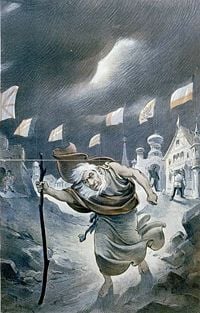
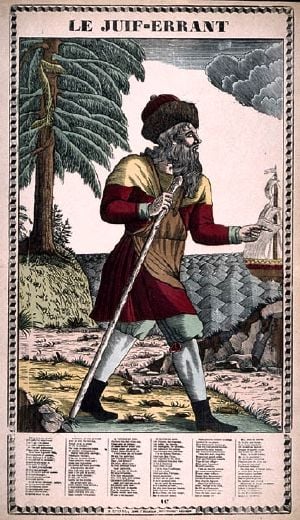

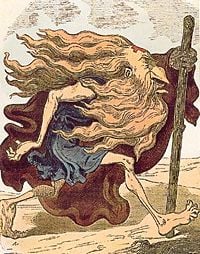
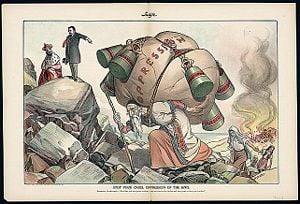
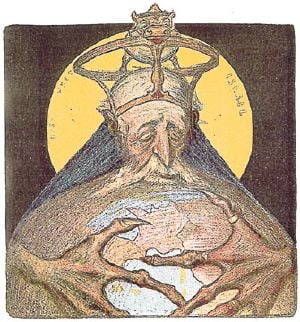

 KSF
KSF